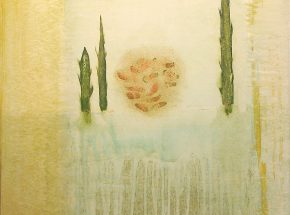

Dorothy Arnold’s work is lyrical, whether we are talking about her dashed-off figure drawings, broadly painted canvases of monumental proportions, or inventively arranged decorative screens evoking Eastern and Western prototypes. In her studio the pieces stand cheek to jowl, making a visit there a nearly pure art experience.
Her figurative drawings – of lithe dancers and pregnant women, of naughty nudes and muscular athletes – bear witness to her love for the magic of image making and her dexterity. I would call her talent truly innate, not arduously acquired through the drudgery of practice.
Consider her drawings. How freely the ink flows across the paper, how deft is the manipulation of her brush. The drawings also attest to her evident immersion in history, as they rightfully, perhaps inevitably, recall traditions from the Renaissance onward. Her rendering of the human figure pays equal homage to David Smith and El Greco, Picasso and Pisanello.
Then there are the paintings. Like the drawings, her acrylic canvases take freedom as their flight path. They push well beyond their calligraphic cousins. The paintings are not restrained by specific subject matter. In the canvases she turns with equal enthusiasm and effectiveness from landscape to still life, from figurative images to abstractions. Her fluidity suggests the world is her stage and that she is more than willing to explore its expanse.
Style is no limitation for her. Some canvases are lathered with rich, thick impasto. Others are impregnated with found materials – glass, string, bits of broken mirrors, beads, and paper goods – consciously compromising any opportunity merely to relish a world of peintre pure. Then there are the clashes, the carefully rendered stripes juxtaposed against splattered paint, as if the prim and proper Lilly Pulitzer found herself suddenly dancing with an acid-dropping punk rocker.
Dorothy’s art is a reminder of the humanity that is her practice. That she would have explored this for almost forty years is an indication of the powers she possesses to sustain an ever-increasing probe of our curious but beautiful existence on this planet. that she would do so with so much feeling and humility, well, this is to be unabashedly and consistently applauded. Bravo to her.
Paul Tucker
Professor Tucker is currently The Paul Hayes Tucker distinguished Professor of Art at the University of Massachusetts Boston. In addition to his many publications, Professor Tucker has served as guest curator for more than a half-dozen major exhibitions worldwide, earning him many awards – and the nickname, “Mr. Monet.”
Website
http://www.dorothyarnold.com
